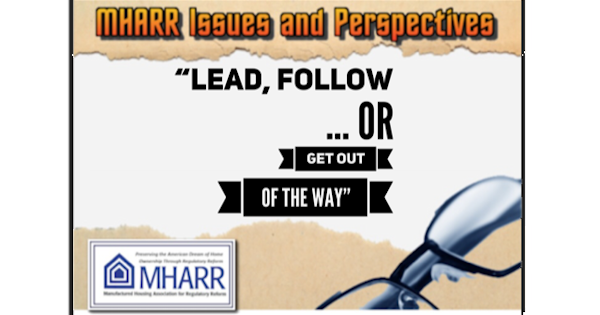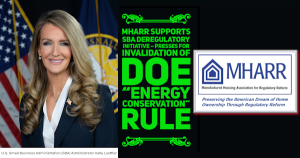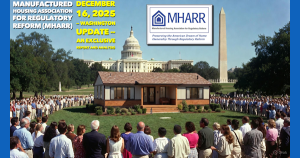The last decade-plus has not been especially kind to the manufactured housing industry and consumers of affordable housing. The 21stCentury began with a great deal of promise for the industry and consumers alike. With record production levels and a comprehensively-reformed federal manufactured housing law (i.e., the Manufactured Housing Improvement Act of 2000) that officially recognized manufactured homes as legitimate, affordable housing for millions of American families, manufactured housing appeared poised to approach production levels at or near 500,000 homes per year.
Soon after, though, production began to trend downward and, within little more than a decade of its record high, cratered to historic lows never before seen in the industry’s modern era. Following that historic low-point, production levels subsequently stabilized and even achieved modest year-over-year gains, to the point that many observers expected the industry to once again meet or surpass the historical 100,000 homes-per-year production benchmark in 2018. But that did not happen. As the industry entered the last quarter of 2018, year-over-year production levels began to decline – slightly at first, but then more markedly – ultimately limiting annual 2018 production to 96,555 homes, better than 2017, but well shy of the 100,000-home benchmark. Even worse, the decline that began in 2018 has now extended into the first quarter of 2019, with cumulative 2019 production to date (i.e., January and February), 11.5% behind the same time period in 2018.
While it is impossible to predict, at this time, whether this nearly six-month production decline represents the resumption of a broader negative long-term trend, or is little more than a hiccup on the road to continued modest recovery, the fact that industry production, for better than a decade, has remained far below its historical norm (i.e., average production of 169,596 homes per year over the past 30 years and 116,600 homes per year over the past 20 years), shouldbe sounding an alarm bell for someone, somewhere, that all is notas it should be, and that urgent action is needed to: (1) identify the problem(s) lying at the heart of this market descent; and (2) take concrete steps to address, to the greatest extent possible and practicable, those problems, once identified.
Fortunately – or unfortunately — one does not have to go too far, or engage in overly-taxing mental gymnastics, to identify a myriad of problems affecting the industry and its consumers. As was noted in the January 2019 edition of MHARR Issues and Perspectives, however, such problems – for the most part— do not currentlylie within the industry’s production sector. This is notto say that there are noproblems affecting the production sector today. There are. As a result, constant vigilance and aggressiveprotection of the industry’s interests (and those of its consumers) – such as that provided by MHARR — is essential. Nor is it to say that the most impactful of the problems affecting the industry’s post-production sector – detailed below — are the onlyproblems affecting that sector. They are not. But the effort to find solutions to — and the resolution of — these matters has got to start somewhere, and it might as well begin with the problems that appear to be having the most profoundly negative long and short-term impacts on the industry and both current and potential consumers of manufactured housing.
Consequently, although it is still burdened to some degree by HUD (and other government) regulatory overreach and related costs in various respects (e.g., the pending U.S. Department of Energy “energy conservation” standards), as well as the potentialreturn of significant regulatory overreach in a future presidential administration as early as 2020 (or, through the continuation, potentially, of a defactosole-source “monitoring” contract), the production (or supply) side of the industry’s economic equation is not the principalculprit in the industry’s failure to reach its full market potential. Instead, it is afterthe industry’s outstanding, inherently affordable homes leave the factory that they hit a proverbial “brick wall.” Indeed, objective analysis shows that the principal market-limitingfactors for the industry today, are clustered, almost entirelyon the demand – or post-production— side of the equation (i.e., once the home leaves the factory) where they have not been addressed either decisively or effectively due, primarily, to the lack of coherent, focused and aggressive leadership and the corresponding absence of an independent, national representative for that segment of the industry.
Interestingly, this parallels the experience of the industry’s production sector in the late 1970s and early-1980s — following the federalization of construction and safety regulation — which led to the establishment of MHARR, in 1985, as an independent, national representative of smaller production sector businesses. The development of an aggressive, independent national representation within the production sector has ultimately led to a situation where the worst regulatory abuses within that realm have been, are being – and will continue to be — effectively addressed and resolved. There is no comparable independent, national representation in the post-production arena, however, which has allowed regulatory and related abuses to either migrate to – or otherwise fester – within that sector, ultimately harming the entireindustry, as well as consumers of affordable housing.
Now, though, both the absence of an independent, national trade representative for the post-production sector and the related long-term failure of the broader industry to effectivelyaddress crucial issues within that sector, have led the MHARR Board of Directors (based on decisions made at its March 2019 Annual Meeting) to “take the bull by the horns” and direct MHARR to aggressively target three major post-production issues which, in its view, have most significantly contributed to the industry’s stagnation over the past decade-plus. These critical matters are: (1) in cooperation with the industry’s state associations, MHARR will select two extreme cases of zoning exclusion and/or discrimination, one involving single-home placements and the other involving the development or expansion of one or more manufactured home communities, and legally challenge the underlying ordinances or related mandates; (2) to similarly challenge other types of local placement restrictions or limitations on individual manufactured homes and manufactured home communities; and (3) to publicly expose the failure of Fannie Mae, Freddie Mac and the Government National Mortgage Association (Ginnie Mae) to fully and properly implement existing law, thereby forcing manufactured housing consumers into higher-cost, allegedly “predatory” purchase loans, while excluding other potential purchasers from the manufactured housing market altogether. Together and in combination, these issues have established a post-production “brick wall” — a perfect economic storm that especially harms smaller industry businesses and HUD Code consumers, while benefitting only the industry’s largest businesses.
Again, while these three issues are not the onlyfactors suppressing the manufactured housing market, by far, they are – both individually and cumulatively — the most significantdrags that exist today on the growth, expansion and positive evolution of the HUD Code housing market, and, conversely, if resolved, either in whole or in part, in favor of the industry and its consumers, would liberate the industry from the severely debilitating limitations that have impeded its growth and its ability to serve many more Americans in need of affordable, non-subsidized housing and homeownership.
Specifically, in the realm of zoning, how can the industry significantly expand its reach and potential market when vast areas of the country are effectively “off limits” to manufactured housing or else sharply restricted, including many of the most heavily populated places in the United States? Regarding placement restrictions, how can the industry thrive, prosper and expand to its full potential as an affordable housing resource, when new manufactured housing communities, in the overwhelming number of cases, cannot be developed and existing communities cannot be expanded or modernized? And, in the area of consumer financing, how many millions of lower and moderate-income Americans are (and have been) excluded from the manufactured housing market because of higher-than-necessary interest rates on the personal property loans that represent nearly 80% of manufactured home consumer loans … rates that are higher-than-necessary because Fannie Mae and Freddie Mac, more than ten years after the enactment of DTS, still do not provide market-significant (or, indeed, any) securitization or secondary market support for such loans — directly contrary to existing law?
Moreover, while these specific problems are open, notorious, and well-known, and have been obviousas a growing source of trouble for the industry over the entire time that manufactured housing production has fallen far below historical averages, they have not been resolved, or even seriously or aggressively addressed by the broader industry (and the Manufactured Housing Institute), which – while collecting significant funding (i.e., dues) from retailers, communities, finance companies, insurers and state associations, among others – has seemed content to let the industry’s largest corporate conglomerates consume an increasing portion of a market that has contracted by 74% over the past 20 years.
On zoning and placement, for example, what has been done (at the national level) to actively press jurisdictions to accept manufactured homes, or, even more importantly, contest and oppose efforts to exclude HUD Code homes, such as occurred just days ago in Bryan, Texas and has been an accelerating trend in recent years? Where is the advocacy? Where is the litigation to prevent the discriminatory exclusion of manufactured homes – and lower and moderate-income manufactured homeowners – from entire jurisdictions? Particularly now that HUD and HUD Secretary Ben Carson have specifically recognized restrictive zoning as a major impediment to affordable housing and homeownership? And what about consumer financing and DTS? What has been done at the national level by the broader industry, for ten-plus years, to demandthe full and proper implementation of DTS for manufactured home personal property loans? And even now, instead of pressing that issue, which directly prejudicesnearly 80% of the manufactured housing finance market, MHI is trumpeting cooperation with Fannie Mae and Freddie Mac on financing for a supposed “new class” of manufactured homes which are neither inherently affordable nor within the mainstream of HUD Code manufactured housing.
As a production sector association, it should not be necessary for MHARR to take the lead on post-production matters. But, for the past 25 years, MHARR has been compelled to lead on many key industry issues. Like reform of the original 1974 manufactured housing law, where passage of a final bill was delayed by a full decadebecause MHI, at the last minute, withdrew its support for language that both MHI and MHARR had previously committed to (which would, among other things, have provided for a removable chassis). Or HERA’s DTS provision, where critical language was provided by MHARR. Or the removal and reassignment of the previous HUD program administrator, which was pressed with HUD by MHARR (while MHI, by its own admission, as reported by the Washington Post, “did not weigh in on [Pamela] Danner’s reassignment”). MHARR’s initiative to aggressively pursue zoning reform (all the way to the Supreme Court if necessary) andthe full and proper implementation of federal law with respect to manufactured home consumer personal property loans, thus represents the fourth time in recent history that MHARR has had to assume the mantle of such leadership because the broader industry – and its erstwhile national representative – have either failed, or simply not tried.
This effort will not be easy and there are no guarantees. But in the absence of a genuine, aggressive effort, what prospects does the industry face? Its defactoexclusion from entire jurisdictions across the United States? Continued blatant discrimination against its homes and its customers? The slow strangulation and elimination of manufactured home land-lease communities which is evolving because of the refusal of most jurisdictions to permit new (or expanded) communities while older communities are closed or “re-purposed?” Decades more delay on DTS from Fannie Mae and Freddie Mac, which have no seeming interest in providing securitization or secondary market support, as directed by Congress, for the vast bulk of the manufactured housing consumer financing market? On all of these fronts, there would be more of the same – endless delay and evolving decay as the industry, closed-in by ever shrinking walls, withers to economic irrelevance.
The industry’s smaller, independent businesses, as represented by MHARR, are unwilling to accept this slow “death of a thousand cuts” without a fight, and will therefore lead with this initiative as far – and as long – as it takes.
Mark Weiss
MHARR is a Washington, D.C.-based national trade association representing the views and interests of independent producers of federally-regulated manufactured housing.
“MHARR-Issues and Perspectives” is available for re-publication in full (i.e., without alteration or substantive modification) without further permission and with proper attribution to MHARR.













